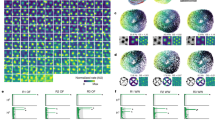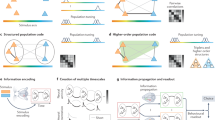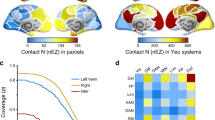Abstract
We examined simultaneously recorded spikes from multiple rat grid cells, to explain mechanisms underlying their activity. Among grid cells with similar spatial periods, the population activity was confined to lie close to a two-dimensional (2D) manifold: grid cells differed only along two dimensions of their responses and otherwise were nearly identical. Relationships between cell pairs were conserved despite extensive deformations of single-neuron responses. Results from novel environments suggest such structure is not inherited from hippocampal or external sensory inputs. Across conditions, cell-cell relationships are better conserved than responses of single cells. Finally, the system is continually subject to perturbations that, were the 2D manifold not attractive, would drive the system to inhabit a different region of state space than observed. These findings have strong implications for theories of grid-cell activity and substantiate the general hypothesis that the brain computes using low-dimensional continuous attractors.
This is a preview of subscription content, access via your institution
Access options
Subscribe to this journal
Receive 12 print issues and online access
$209.00 per year
only $17.42 per issue
Buy this article
- Purchase on Springer Link
- Instant access to full article PDF
Prices may be subject to local taxes which are calculated during checkout







Similar content being viewed by others
References
Hopfield, J. Neural networks and physical systems with emergent collective computational abilities. Proc. Natl. Acad. Sci. USA 79, 2554–2558 (1982).
Ben-Yishai, R., Bar-Or, R. & Sompolinsky, H. Theory of orientation tuning in visual cortex. Proc. Natl. Acad. Sci. USA 92, 3844–3848 (1995).
Seung, H.S. How the brain keeps the eyes still. Proc. Natl. Acad. Sci. USA 93, 13339–13344 (1996).
Zhang, K. Representation of spatial orientation by the intrinsic dynamics of the head-direction cell ensemble: a theory. J. Neurosci. 16, 2112–2126 (1996).
Seung, H.S. & Lee, D. The manifold ways of perception. Science 290, 2268–2269 (2000).
Latham, P.E., Deneve, S. & Pouget, A. Optimal computation with attractor networks. J. Physiol. Paris 97, 683–694 (2003).
Cannon, S.C. & Robinson, D. Loss of the neural integrator of the oculomotor system from brain stem lesions in monkey. J. Neurophysiol. 57, 1383–1409 (1987).
Blair, H.T. & Sharp, P.E. Anticipatory head direction signals in anterior thalamus: evidence for a thalamocortical circuit that integrates angular head motion to compute head direction. J. Neurosci. 15, 6260–6270 (1995).
Samsonovich, A. & McNaughton, B.L. Path integration and cognitive mapping in a continuous attractor neural network model. J. Neurosci. 17, 5900–5920 (1997).
Taube, J.S., Muller, R.U. & Ranck, J.B. Head-direction cells recorded from the postsubiculum in freely moving rats. ii. effects of environmental manipulations. J. Neurosci. 10, 436–447 (1990).
Aksay, E., Gamkrelidze, G., Seung, H.S., Baker, R. & Tank, D.W. In vivo intracellular recording and perturbation of persistent activity in a neural integrator. Nat. Neurosci. 4, 184–193 (2001).
Fuhs, M.C. & Touretzky, D.S. A spin glass model of path integration in rat medial entorhinal cortex. J. Neurosci. 26, 4266–4276 (2006).
Burak, Y. & Fiete, I. Do we understand the emergent dynamics of grid cell activity? J. Neurosci. 26, 9352–9354 (2006).
Guanella, A., Kiper, D. & Verschure, P. A model of grid cells based on a twisted torus topology. Int. J. Neural Syst. 17, 231–240 (2007).
Burak, Y. & Fiete, I.R. Accurate path integration in continuous attractor network models of grid cells. PLoS Comput. Biol. 5, e1000291 (2009).
Romo, R., Brody, C.D., Hernández, A. & Lemus, L. Neuronal correlates of parametric working memory in the prefrontal cortex. Nature 399, 470–473 (1999).
Miller, P., Brody, C., Romo, R. & Wang, X.-J. A recurrent network model of somatosensory parametric working memory in the prefrontal cortex. Cereb. Cortex 13, 1208–1218 (2003).
Ringach, D.L., Hawken, M.J. & Shapley, R. Dynamics of orientation tuning in macaque primary visual cortex. Nature 387, 281–284 (1997).
Aksay, E. et al. History dependence of rate covariation between neurons during persistent activity in an oculomotor integrator. Cereb. Cortex 13, 1173–1184 (2003).
Hafting, T., Fyhn, M., Molden, S., Moser, M.-B. & Moser, E. Microstructure of a spatial map in the entorhinal cortex. Nature 436, 801–806 (2005).
O'Keefe, J. & Burgess, N. Dual phase and rate coding in hippocampal place cells: theoretical significance and relationship to entorhinal grid cells. Hippocampus 15, 853–866 (2005).
McNaughton, B.L., Battaglia, F.P., Jensen, O., Moser, E.I. & Moser, M.-B. Path integration and the neural basis of the 'cognitive map'. Nat. Rev. Neurosci. 7, 663–678 (2006).
Burgess, N., Barry, C. & O'Keefe, J. An oscillatory interference model of grid cell firing. Hippocampus 17, 801–812 (2007).
Fyhn, M., Hafting, T., Treves, A., Moser, M.-B. & Moser, E.I. Hippocampal remapping and grid realignment in entorhinal cortex. Nature 446, 190–194 (2007).
Muller, R. & Kubie, J. The effects of changes in the environment on the spatial firing of hippocampal complex-spike cells. J. Neurosci. 7, 1951–1968 (1987).
Quirk, G.J., Muller, R.U. & Kubie, J.L. The firing of hippocampal place cells in the dark depends on the rat's recent experience. J. Neurosci. 10, 2008–2017 (1990).
Bostock, E., Muller, R. & Kubie, J. Experience-dependent modifications of hippocampal place cell firing. Hippocampus 1, 193–205 (1991).
Markus, E.J. et al. Interactions between location and task affect the spatial and directional firing of hippocampal neurons. J. Neurosci. 15, 7079–7094 (1995).
Wood, E., Dudchenko, P., Robitsek, R. & Eichenbaum, H. Hippocampal neurons encode information about different types of memory episodes occurring in the same location. Neuron 27, 623–633 (2000).
Barry, C., Hayman, R., Burgess, N. & Jeffery, K.J. Experience-dependent rescaling of entorhinal grids. Nat. Neurosci. 10, 682–684 (2007).
Barry, C., Ginzberg, L., O'Keefe, J. & Burgess, N. Grid cell firing patterns signal environmental novelty by expansion. Proc. Natl. Acad. Sci. USA 109, 17687–17692 (2012).
Stensola, H. et al. The entorhinal grid map is discretized. Nature 492, 72–78 (2012).
Fiete, I.R., Burak, Y. & Brookings, T. What grid cells convey about rat location. J. Neurosci. 28, 6858–6871 (2008).
Artin, M. Algebra (Prentice Hall, 1991).
Sargolini, F. et al. Conjunctive representation of position, direction, and velocity in entorhinal cortex. Science 312, 758–762 (2006).
Morris, R. Spatial localization does not require the presence of local cues. Learn. Motiv. 12, 239–260 (1981).
Steele, R. & Morris, R. Delay-dependent impairment of a matching-to-place task with chronic and intrahippocampal infusion of the NMDA-antagonist D-AP5. Hippocampus 9, 118–136 (1999).
Frank, L., Stanley, G. & Brown, E. Hippocampal plasticity across multiple days of exposure to novel environments. J. Neurosci. 24, 7681–7689 (2004).
Wilson, M.A. & McNaughton, B.L. Dynamics of the hippocampal ensemble code for space. Science 261, 1055–1058 (1993).
Karlsson, M.P. & Frank, L.M. Network dynamics underlying the formation of sparse, informative representations in the hippocampus. J. Neurosci. 28, 14271–14281 (2008).
Bonnevie, T. et al. Grid cells require excitatory drive from the hippocampus. Nat. Neurosci. 16, 309–317 (2013).
Pastoll, H., Solanka, L., van Rossum, M.C. & Nolan, M.F. Feedback inhibition enables theta-nested gamma oscillations and grid firing fields. Neuron 77, 141–154 (2013).
Couey, J.J. et al. Recurrent inhibitory circuitry as a mechanism for grid formation. Nat. Neurosci. 16, 318–324 (2013).
Welinder, P.E., Burak, Y. & Fiete, I.R. Grid cells: the position code, neural network models of activity, and the problem of learning. Hippocampus 18, 1283–1300 (2008).
Sreenivasan, S. & Fiete, I.R. Grid cells generate an analog error-correcting code for singularly precise neural computation. Nat. Neurosci. 14, 1330–1337 (2011).
Burak, Y. & Fiete, I.R. Fundamental limits on persistent activity in networks of noisy neurons. Proc. Natl. Acad. Sci. USA 109, 17645–17650 (2012).
Stevens, C.F. & Wang, Y. Changes in reliability of synaptic function as a mechanism for plasticity. Nature 371, 704–707 (1994).
Domnisoru, C., Kinkhabwala, A.A. & Tank, D.W. Membrane potential dynamics of grid cells. Nature 495, 199–204 (2013).
Schmidt-Hieber, C. & Häusser, M. Cellular mechanisms of spatial navigation in the medial entorhinal cortex. Nat. Neurosci. 16, 325–331 (2013).
Welday, A., Shlifer, I., Bloom, M., Zhang, K. & Blair, H. Cosine directional tuning of theta cell burst frequencies: evidence for spatial coding by oscillatory interference. J. Neurosci. 31, 16157–16176 (2011).
Langston, R.F. et al. Development of the spatial representation system in the rat. Science 328, 1576–1580 (2010).
Brandon, M.P. et al. Reduction of theta rhythm dissociates grid cell spatial periodicity from directional tuning. Science 332, 595–599 (2011).
Acknowledgements
We are grateful to D. Tank for insightful comments. We thank members of the Moser laboratory for public release of some of their data sets, which we used in this study. I.R.F. is funded as a Sloan Foundation Fellow, a Searle Scholar and a McKnight Scholar. We acknowledge funding from the Wellcome Trust, UK and the Office of Naval Research through ONR MURI N00014-10-1-0936 and the ONR-Young Investigator Program to I.R.F.
Author information
Authors and Affiliations
Contributions
K.Y. performed the analysis. K.Y., M.A.B., C.B., N.B. and I.R.F. contributed ideas and plans for the analysis. C.B. and R.H. collected some of the data presented. K.Y. and I.R.F. wrote the paper with input from M.A.B., C.B. and N.B.
Corresponding author
Ethics declarations
Competing interests
The authors declare no competing financial interests.
Supplementary information
Supplementary Figures and Text
Supplementary Figures 1–6 (PDF 574 kb)
Rights and permissions
About this article
Cite this article
Yoon, K., Buice, M., Barry, C. et al. Specific evidence of low-dimensional continuous attractor dynamics in grid cells. Nat Neurosci 16, 1077–1084 (2013). https://doi.org/10.1038/nn.3450
Received:
Accepted:
Published:
Issue Date:
DOI: https://doi.org/10.1038/nn.3450
This article is cited by
-
Environment geometry alters subiculum boundary vector cell receptive fields in adulthood and early development
Nature Communications (2024)
-
Attractor dynamics reflect decision confidence in macaque prefrontal cortex
Nature Neuroscience (2023)
-
A unifying perspective on neural manifolds and circuits for cognition
Nature Reviews Neuroscience (2023)
-
Ketamine evoked disruption of entorhinal and hippocampal spatial maps
Nature Communications (2023)
-
Complementary task representations in hippocampus and prefrontal cortex for generalizing the structure of problems
Nature Neuroscience (2022)



